

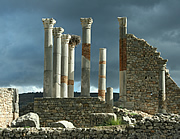
We returned to Morocco in 2008 lured by the medieval city of Fes.
While here we made a journey to the fascinating Roman city of Volubilis, 60km west, one of the most extensive in all Africa, with some wonderful mosaics still in situ and to Meknes, one of the old Imperial cities.
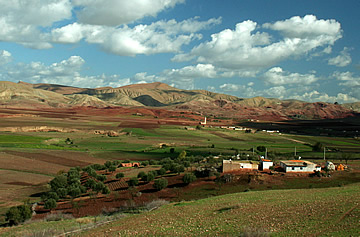
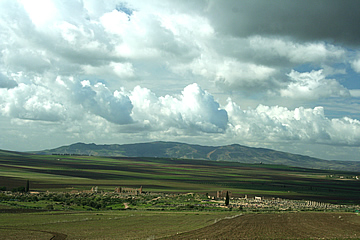
An easy excursion from Fes is to visit the magnificent Roman remains at Volubilis. We hired a car and driver to take us here and also to Meknes on the same day (800Dh).
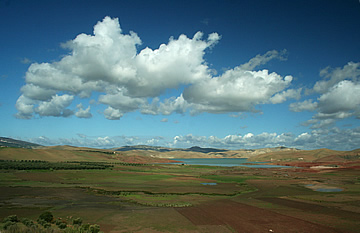
It was lovely to get out of the city and see some of the countryside which is surprisingly fertile. Lots of olive groves, vegetables and almond trees nearer Volubilis but apparently these do better in the south. Our driver was very informative as we drove along. We passed through towns where busy markets were in progress and made one stop overlooking a wide valley with a huge reservoir but the water is too salty to drink so it's only good for fish and hydroelectricity. We also stopped on the road above Volubilis where there is an excellent view over the city.
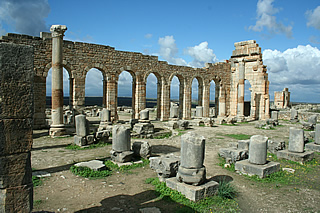
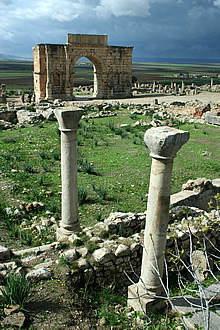
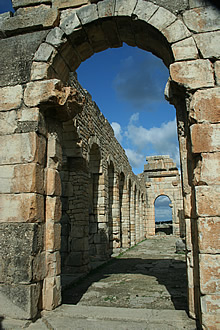
As far as the Romans were concerned Volubilis really was the end of the road - all imperial roads stopped here at one of the most distant points of the Empire. Settled by Carthaginian traders in the third century B.C. it was annexed by the Romans around 40 A.D. and then abandoned aound 285 A.D.
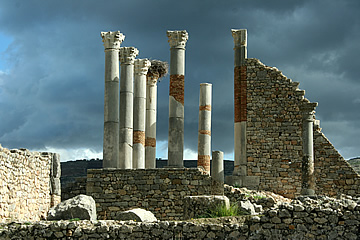

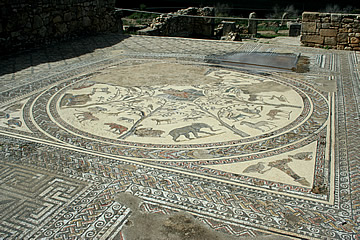
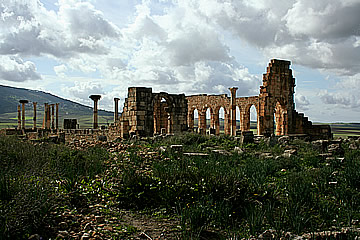
One of the most striking aspects of the city ruins are the many mosaics which remain in place. In the House of Orpheus there are several fine examples, including a large circular mosaic with Orpheus playing his lyre surrounded by animals and birds.
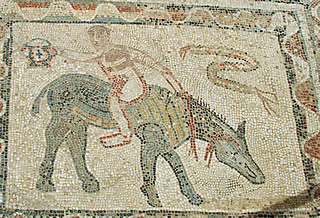
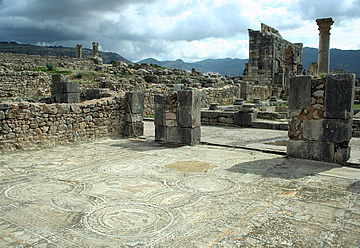
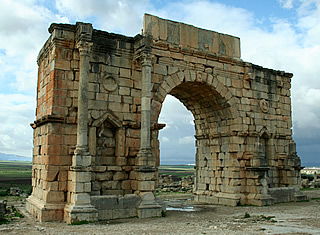
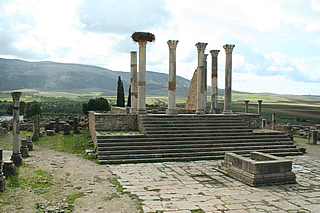
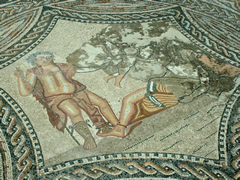
Volubilis was hugely important to the Romans, particularly as a supplier of grain and olives, and numbered around 20,000 inhabitants in its heyday. The remains which can be seen today date from this period of the second and third century A.D. They give a good sense of city life as the main roads and foundations of many buildings are easily identified and these include several mansions, fine examples of courtyard houses with a central rectangular court with a pool surrounded by rooms, and many small shops lining the Decumanus Maximus. Best preserved of the buildings are the Basilica and Triumphal Arch at the entrance to the Decumanus Maximus.
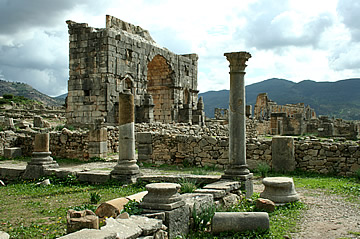
The columns of the Capitol still stand mostly intact. This small building contained a temple and altar and was, as usual throughout the Empire, dedicated to Capitoline Jove, Juno and Minerva.

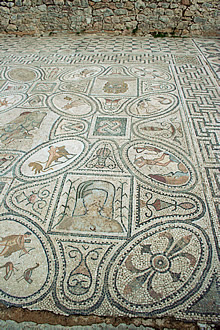
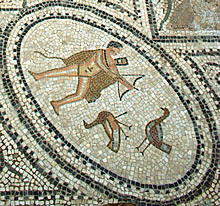 Slaying the Stymphalian Birds
Slaying the Stymphalian Birds 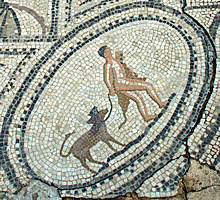 Capturing a rather tame Cerberus
Capturing a rather tame CerberusThree of the most impressive mosaic floors in extremely good condition show the Labours of Hercules, Diana Bathing and the Abduction of Hylas by Nymphs. They are all virtually complete and must have been commissioned by the wealthiest of citizens of Volubilis.
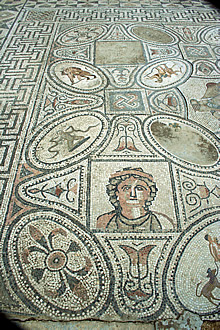
The Hercules mosaic depicts all of the labours of Hercules in oval panels:
Slay the Nemean Lion.
Slay the Lernaean Hydra.
Capture the Golden Hind of Artemis
Capture the Erymanthean Boar.
Clean the Augean stables in a single day
Slay the Stymphalian Birds
Capture the Cretan Bull
Capture the Mares of Diomedes
Steal the Girdle of Hippolyte, the Amazon Queen
Steal the Cattle of Geryon
Collect the Apples of the Hesperides
Capture Cerberus


My favourite mosaic here is Diana Bathing. It is very beautifully designed and a real work of art.
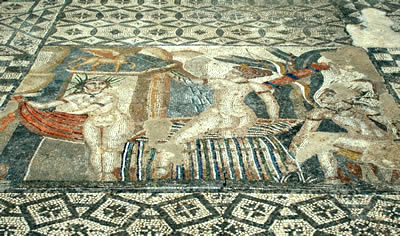
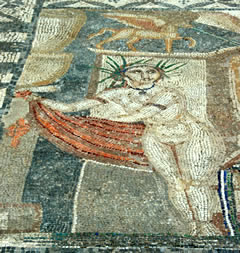
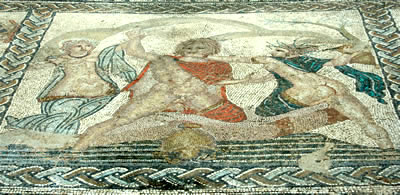
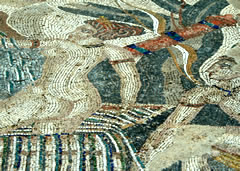
Diana emerges from her bath; it looks as though a stream of water is flowing from the mouth of a winged horse in the top left of the mosaic and that the bath is overflowing. An attendant holds a large towel or robe ready.
Hylas was a boy loved by Hercules. He was carried off by nymphs while drawing water from a well.
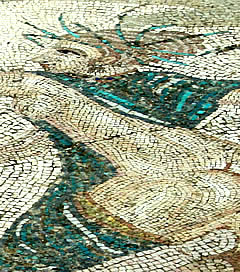
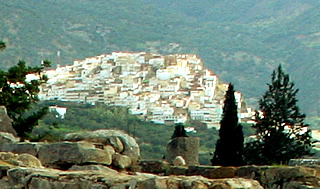
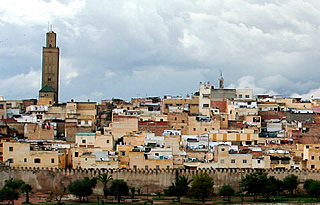
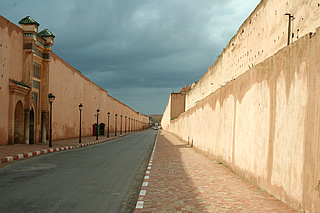
We left Volubilis as a rainstorm hit. We were on our way to Meknes via Mouley Idris, a pretty little white town ranged across the hillsides not far from Volubilis. It is named after the saint and creator of the first Arab dynasty in Morocco. For non-Muslims there is nothing that can be visited here, including the saint's tomb at the heart of the town.
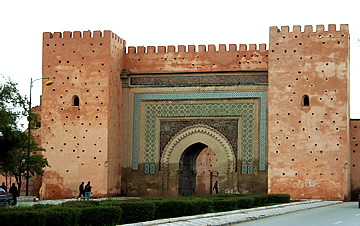
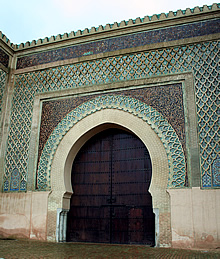 Beautiful shape and decoration to the main entrance of Bab Mansour.
Beautiful shape and decoration to the main entrance of Bab Mansour.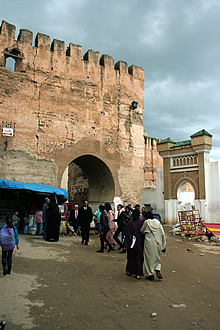 Away from the tourist trail!
Away from the tourist trail! Meknes is essentially the creation of Moulay Ismail, who expanded it from a small provincial town to a great city during his 55 year reign from 1672. Moulay Ismail sounds like a particularly nasty piece of work - even by the standards of the times. He began his reign by displaying 700 heads at Fes! He was an enthusiastic builder of palaces and bridges, ports and towns. Meknes has many imposing gates and extensive walls but has not weathered the passage of time well, though there is enough here to provide a good impression of its grandeur in times gone by. Bab Mansour is the finest decorated of the gates but I rather preferred those with unadorned crenellated walls and towers.
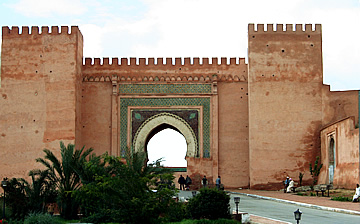
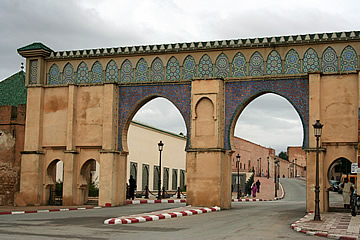 Bab er Rih - Gate of the Winds
Bab er Rih - Gate of the WindsOur driver gave us a good tour around the gates of the city before stopping and letting us wander around on our own. In our short meanderings we passed through the Bab er Rih and down a long street walled on both sides, through a gate into a residential and business area and down through the town. It was busy with people and way off the tourist trail. This in fact, we learned later, is the run-down area of Dar el-Kebira, the great palace complex. The Rough Guide says that the "imperial structures - the legendary fifty palaces - can still be made out between and above the houses" but we didn't spot anything that looked remotely palatial.
On the other side of the road to Bab er Rih is Habs Kara, the underground cavernous prison where 60,000 slaves were kept, among them rumoured to be 40,000 Christian prisoners of war. It is said that the prisoners were chained to the walls and made to sleep standing up but there surely isn't enough wall space for all 60,000 of them! It was very poorly lit down here and very ruinous - heaven knows what was running around in the dark!
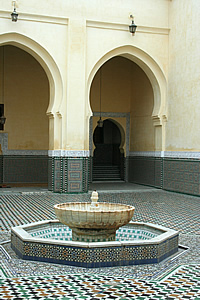
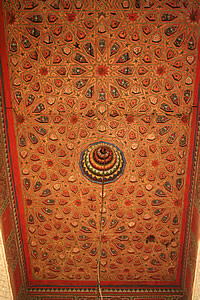
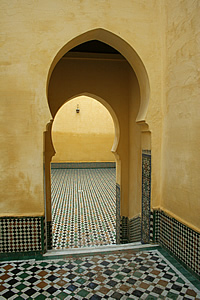
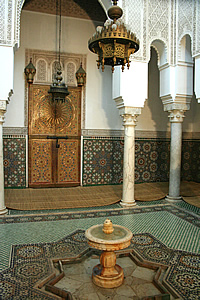
The Mausoleum is the only Muslim shrine that we non-Muslims may visit. In the seventeenth century Moulay Ismail was one of Morocco's greatest rulers and it was he who made Meknes the capital city.
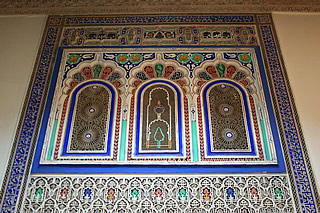
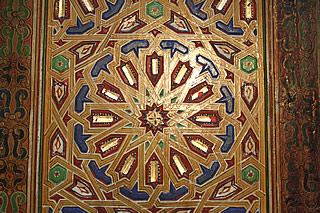
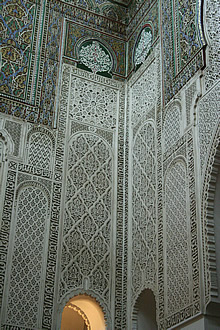
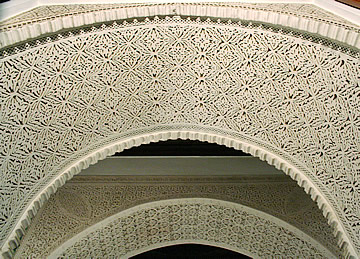
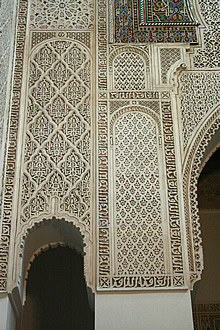
A series of cool empty courts leads to a courtyard where shoes must be removed before entering the mosque. Inside is a very beautiful ante-chamber to the actual tomb - the tomb area itself cannot be visited by non-Muslims.
The carvingin the ante-chamber is beautifully intricate and there is a great sense of symmetry in all of the exquisite decoration, both in placemenmt and the use of colour.
We were lucky to be here virtually alone and able to spend time to appreciate the skill which had gone into creating this beautiful room.
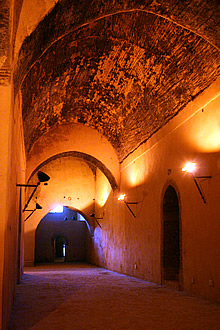
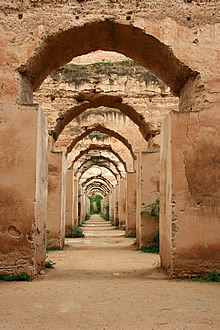
By far the most interesting visit we made in Meknes was to the massive imperial granaries and stables of Moulay Ismail. The granaries are composed of enormous vaulted chambers which were used to store huge amounts of supplies in case of a siege or a failure in crops.
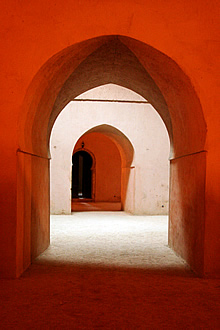
The stables were said to have room for over twelve thousand horses. They now lie in ruins, a series of vast connecting spaces open to the sky.